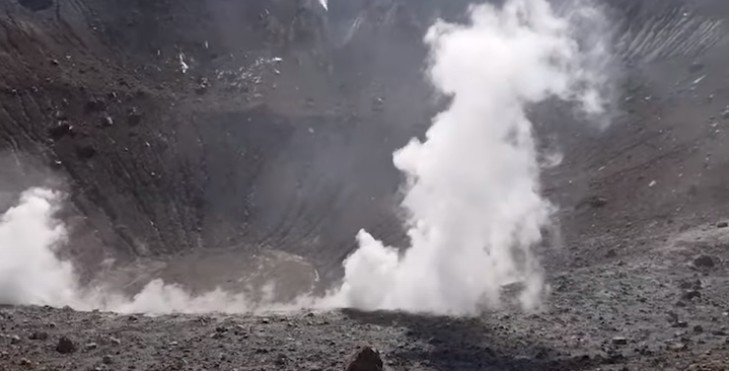INGV monitoring the fumaroles at Vulcano, Italy

Due to the recent upgrade of alert level for Vulcano volcano in Sicily, Italy from Green to Yellow, researchers of the Palermo Section of the INGV have increased their monitoring of the volcano.
On October 12, they sampled gases at four high-temperature fumaroles on the rim and inner slope of the La Fossa crater, and a low-temperature at the Levante beach.
The samples were handed to the laboratories of the Palermo Section for chemical and isotopic analysis. Concurrently with the sampling, the scientists carried out temperature measurements.
The temperatures of the gas emitted from the fumaroles regularly exceed 100 °C (212 °F) and cannot be measured with normal thermometers. The instrument used (seen in the still image at the beginning of the video) is a type K thermocouple.
Measured values can change with time and vary strongly among the different fumaroles. The fumarole that was measured in this video had a temperature of 344 °C (651 °F).

INGV raised the alert level2 from Green to Yellow on October 1, after their monitoring systems detected changes in geophysical and geochemical signals, in particular those linked to the activity of the hydrothermal system that feeds the fumaroles of the La Fossa crater.
The temperature of the gases emitted by the fumaroles on the crater rim has increased during the summer of 2021 and the composition of the gases shows an increase in CO2 and SO2 (carbon dioxide and sulfur dioxide).
Local micro-seismicity linked to the dynamics of the fumarolic system has also shown an increase in recent weeks.
In recent centuries, volcanic activity at the volcano has concentrated at the La Fossa cone and the last eruption took place between August 3, 1888, and March 22, 1890 (Volcanic Explosivity Index of 3).
Since the last eruption, La Fossa has gone through periods of different degassing intensities – from weak to strong – returning to emit large quantities of gas starting from 1977.
This gas emission activity occurs from a medium-temperature fumarolic field (100 °C / 212 °F <T <450 °C / 842 °F) in the northern portion of the crater.
Hydrothermal manifestations of low temperature (100 °C / 212 °F) are instead present in the Faraglioni and Baia di Levante area.
Between 1916 and 1927 and between 1988 and 1995 two notable increases in fumarolic gas temperatures were observed, up to 623 °C (1 153 °F) and 700 °C (1 292 °F), respectively. In the most recent crisis, monitoring systems also detected seismic activity and deformations.


Geological summary
The word volcano is derived from Vulcano stratovolcano in Italy's Aeolian Islands.
Vulcano was constructed during six stages over the past 136 000 years.
Two overlapping calderas, the 2.5 km (1.5 miles) wide Caldera del Piano on the SE and the 4 km (2.5 miles) wide Caldera della Fossa on the NW, were formed at about 100 000 and 24 000 – 15 000 years ago, respectively, and volcanism has migrated north over time.
La Fossa cone, active throughout the Holocene and the location of most historical eruptions, occupies the 3 km (1.8 miles) wide Caldera della Fossa at the NW end of the elongated 3 x 7 km (1.8 x 4.3 miles) island.
The Vulcanello lava platform is a low, roughly circular peninsula on the northern tip of Vulcano that was formed as an island beginning more than 2 000 years ago and was connected to the main island in about 1 550 CE.
Vulcanello is capped by three pyroclastic cones and was active intermittently until the 16th century. The latest eruption from Vulcano consisted of explosive activity from the Fossa cone from 1898 to 1900.
This volcano is located within the Isole Eolie (Aeolian Islands), a UNESCO World Heritage property.3
References:
1 INGV monitoring of the fumaroles at Vulcano – YT
2 Vulcano volcano Alert Level raised to Yellow, last eruption took place in 1890, Italy – The Watchers
3 Vulcano – Geological summary – GVP
Featured image credit: INGV

Commenting rules and guidelines
We value the thoughts and opinions of our readers and welcome healthy discussions on our website. In order to maintain a respectful and positive community, we ask that all commenters follow these rules.